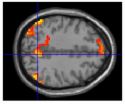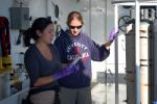(Press-News.org) Brain scans of children with attention-deficit/hyperactivity disorder (ADHD) have shown for the first time why people affected by the condition sometimes have difficulty in concentrating. The study, by experts at The University of Nottingham, may explain why parents often say that their child can maintain concentration when they are doing something that interests them, but struggles with boring tasks.
Using a 'Whac-a-Mole' style game, researchers from the Motivation, Inhibition and Development in ADHD Study (MIDAS) group found evidence that children with ADHD require either much greater incentives — or their usual stimulant medication — to focus on a task.
The research, funded by the Wellcome Trust, found that when the incentive was low, the children with ADHD failed to "switch off" brain regions involved in mind-wandering. When the incentive was high, however, or they were taking their medication, their brain activity was indistinguishable from a typically-developing non-ADHD child.
Professor Chris Hollis, in the School of Community Health Sciences, led the study. He said: "The results are exciting because for the first time we are beginning to understand how in children with ADHD incentives and stimulant medication work in a similar way to alter patterns of brain activity and enable them to concentrate and focus better. It also explains why in children with ADHD their performance is often so variable and inconsistent, depending as it does on their interest in a particular task."
ADHD is the most common mental health disorder in childhood, affecting around one in 50 children in the UK. Children with ADHD are excessively restless, impulsive and distractible, and experience difficulties at home and in school. Although no cure exists for the condition, symptoms can be reduced by medication and/or behavioural therapy. The drug methylphenidate (more often known by the brand name Ritalin) is commonly used to treat the condition.
Previous studies have shown that children with ADHD have difficulty in 'switching-off' the default mode network (DMN) in their brains. This network is usually active when we are doing nothing, giving rise to spontaneous thoughts or 'daydreams', but is suppressed when we are focused on the task before us. In children with ADHD, however, it is thought that the DMN may be insufficiently suppressed on 'boring' tasks that require focused attention.
The MIDAS group researchers, which included Dr Martin Batty and Dr Elizabeth Liddle, compared brain scans of 18 children with ADHD, aged between nine and 15 years old, against scans of a similar group of children without the condition as both groups took part in a task designed to test how well they were able to control their behaviour. The children with ADHD were tested when they were taking their methylphenidate and when they were off their medication. The findings are published in the Journal of Child Psychology and Psychiatry.
Whilst lying in a magnetic resonance imaging (MRI) scanner, which can be used to measure activity in the brain, the children played a computer game in which green aliens were randomly interspersed with less frequent black aliens, each appearing for a short interval. Their task was to 'catch' as many green aliens as possible, while avoiding catching black aliens. For each slow or missed response, they would lose one point; they would gain one point for each timely response.
To study the effect of incentives, the reward for avoiding catching the black alien was then increased to five points, with a five-point penalty incurred for catching the wrong alien.
By studying the brain scans, the researchers were able to show that typically developing children switched off their DMN network whenever they saw an item requiring their attention. However, unless the incentive was high, or they had taken their medication, the children with ADHD would fail to switch off the DMN and would perform poorly. This effect of incentives was not seen in children without ADHD — activity in their DMN was switched off by items requiring their attention regardless of the incentive on offer.
Dr Batty said: "Using brain imaging we have been able to see inside the children's heads and observe what it is about ADHD that is stopping them concentrating. Most people are able to control their 'daydreaming' state and focus on the task at hand. This is not the case with children with ADHD. If a task is not sufficiently interesting, they cannot switch off their background brain activity and they are easily distracted. Making a task more interesting — or providing methylphenidate — turns down the volume and allows them to concentrate."
Dr Liddle said: "These findings help explain one of the interesting characteristics of ADHD — that children with the condition appear able to control themselves much better when motivated to do so.
"The common complaint about children with ADHD is that 'he can concentrate and control himself fine when he wants to', so some people just think the child is being naughty when he misbehaves. We have shown that this may be a very real difficulty for them. The off-switch for their 'internal world' seems to need a greater incentive to function properly and allow them to attend to their task."
INFORMATION:
Details of their research can be found at: Task-related Default Mode Network modulation and inhibitory control in ADHD: effects of motivation and methylphenidate. Journal of Child Psychology and Psychiatry; e-pub in advance, Nov 12 2010.
Faulty 'off-switch' stops children with ADHD from concentrating
2011-01-07
ELSE PRESS RELEASES FROM THIS DATE:
NIST telescope calibration may help explain mystery of universe's expansion
2011-01-07
Is the expansion of the universe accelerating for some unknown reason? This is one of the mysteries plaguing astrophysics, and somewhere in distant galaxies are yet-unseen supernovae that may hold the key. Now, thanks to a telescope calibrated by scientists from the National Institute of Standards and Technology (NIST), Harvard University and the University of Hawaii, astrophysicists can be more certain of one day obtaining an accurate answer.
The NIST scientists traveled to the summit of Haleakala volcano in Hawaii to fine-tune the operation of billions of light-collecting ...
IPv6 guide provides path to secure deployment of next-generation Internet protocol
2011-01-07
As the day draws nearer for the world to run out of the unique addresses that allow us to use the Internet—now predicted to happen by the end of 2012—researchers at the National Institute of Standards and Technology (NIST) have issued a guide for managers, network engineers, transition teams and others to help them deploy the next generation Internet Protocol (IPv6) securely.
Guidelines for the Secure Deployment of IPv6 (NIST Special Publication 800-119), describes the features of IPv6 and the possible related security impacts, provides a comprehensive survey of mechanisms ...
2 publications recommend organization-wide IT security risk management
2011-01-07
Two new draft publications from the National Institute of Standards and Technology (NIST) provide the groundwork for a three-tiered risk-management approach that encompasses computer security risk planning from the highest levels of management to the level of individual systems. The draft documents have been released for public comment.
Both publications are a part of NIST's risk management guidelines, which have been developed in support of the Federal Information Security Management Act (FISMA), and adopted government wide to improve the security of government systems ...
Princeton scientists construct synthetic proteins that sustain life
2011-01-07
In a groundbreaking achievement that could help scientists "build" new biological systems, Princeton University scientists have constructed for the first time artificial proteins that enable the growth of living cells.
The team of researchers created genetic sequences never before seen in nature, and the scientists showed that they can produce substances that sustain life in cells almost as readily as proteins produced by nature's own toolkit.
"What we have here are molecular machines that function quite well within a living organism even though they were designed ...
High dietary fat, cholesterol linked to increased risk of breast cancer
2011-01-07
(PHILADELPHIA) Elevated fat and cholesterol levels found in a typical American-style diet play an important role in the growth and spread of breast cancer, say researchers at the Kimmel Cancer Center at Jefferson.
The study, published in the January issue of The American Journal of Pathology, examines the role of fat and cholesterol in breast cancer development using a mouse model. The results show that mice fed a Western diet and predisposed to develop mammary tumors, can develop larger tumors that are faster growing and metastasize more easily, compared to animals eating ...
Drinking recycled water?
2011-01-07
Madison, WI December 28, 2010 – The Australian Government National Water Commission funded a study to establish an approach to assess the quality of water treated using managed aquifer recharge. Researchers at Australia's CSIRO Land and Water set out to determine if the en product would meet standard drinking water guidelines.
At the Parafield Aquifer Storage, Transfer and Recovery research project in South Australia, the team of scientists harvested storm water from an urban environment, treated it in a constructed wetland, stored it in an aquifer, and then recovered ...
Fermi's Large Area Telescope sees surprising flares in Crab Nebula
2011-01-07
Menlo Park, Calif. — The Crab Nebula, one of our best-known and most stable neighbors in the winter sky, is shocking scientists with a propensity for fireworks—gamma-ray flares set off by the most energetic particles ever traced to a specific astronomical object. The discovery, reported today by scientists working with two orbiting telescopes, is leading researchers to rethink their ideas of how cosmic particles are accelerated.
"We were dumbfounded," said Roger Blandford, who directs the Kavli Institute for Particle Astrophysics and Cosmology, jointly located at ...
NOAA-led team measures atmosphere's self-cleaning capacity
2011-01-07
An international, NOAA-led research team took a significant step forward in understanding the atmosphere's ability to cleanse itself of air pollutants and some other gases, except carbon dioxide. The issue has been controversial for many years, with some studies suggesting the self-cleaning power of the atmosphere is fragile and sensitive to environmental changes, while others suggest greater stability. And what researchers are finding is that the atmosphere's self-cleaning capacity is rather stable.
New analysis published online today in the journal Science shows that ...
UCSB, Texas A&M scientists find methane gas concentrations have returned to near-normal levels
2011-01-07
(Santa Barbara, Calif.) –– Calling the results "extremely surprising," researchers from the University of California, Santa Barbara and Texas A&M University report that methane gas concentrations in the Gulf of Mexico have returned to near normal levels only months after a massive release occurred following the Deepwater Horizon oil rig explosion.
Findings from the research study, led by oceanographers John Kessler of Texas A&M and David Valentine of UCSB, were published today in Science Xpress, in advance of their publication in the journal Science. The findings show ...
Freshwater methane release changes greenhouse gas equation
2011-01-07
AMES, Iowa – An international team of scientists has released data indicating that greenhouse gas uptake by continents is less than previously thought because of methane emissions from freshwater areas.
John Downing, an Iowa State University professor in the ecology, evolution and organismal biology department, is part of an international team that concluded that methane release from inland waters is higher than previous estimates.
The study, published in the journal Science, indicates that methane gas release from freshwater areas changes the net absorption of greenhouse ...



